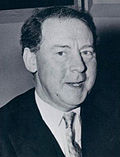A request that this article title be changed to Leeds South is under discussion . Please do not move this article until the discussion is closed. |
| Leeds South | |
|---|---|
| Borough constituency for the House of Commons | |
 Interactive map of boundaries since 2024 | |
 Boundary within Yorkshire and the Humber | |
| County |
|
| Current constituency | |
| Created | 2024 |
| Member of Parliament | Hilary Benn (Labour) |
| Seats | One |
| Created from |
|
| 1885–1983 | |
| Seats | One |
| Type of constituency | Borough constituency |
| Created from | Leeds |
| Replaced by | Leeds Central and Morley & Leeds South [1] |
Leeds South is a parliamentary constituency [n 1] in the city of Leeds, West Yorkshire, which returns one Member of Parliament (MP) to the House of Commons of the Parliament of the United Kingdom. The constituency existed from 1885 to 1983 and was recreated in 2024 following the 2023 Periodic Review of Westminster constituencies. [2]
Contents
- History
- Boundaries
- 1885–1983
- 2024–present
- Members of Parliament
- MPs 1885–1983
- MPs since 2024
- Elections
- Elections in the 2020s
- Elections in the 2010s
- Election results 1885–1983
- Elections in the 1880s
- Elections in the 1890s
- Elections in the 1900s
- Elections in the 1910s
- Elections in the 1920s
- Elections in the 1930s
- Elections in the 1940s
- Elections in the 1950s
- Elections in the 1960s
- Elections in the 1970s
- See also
- Notes
- References
- External links
In the 2024 general election, the seat was won by Hilary Benn of the Labour Party, who serves as Secretary of State for Northern Ireland in the government of Keir Starmer. [3] [4] Benn had represented Leeds Central, the main predecessor of Leeds South, since 1999.
Leeds South was the seat of the former Leader of the Labour Party, the late Hugh Gaitskell, and the former Home Secretary Merlyn Rees.





